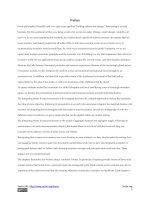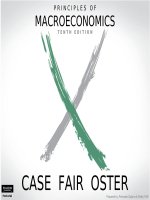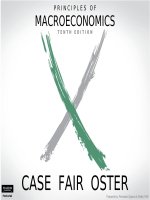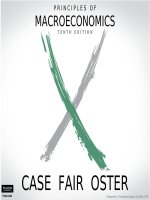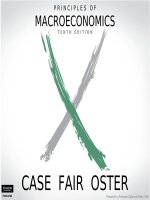Principles of macroeconomics 10e by case fair oster ch04
Bạn đang xem bản rút gọn của tài liệu. Xem và tải ngay bản đầy đủ của tài liệu tại đây (1.08 MB, 44 trang )
PRINCIPLES OF
MACROECONOMICS
PART I Introduction to Economics
TENTH
EDITION
CASE FAIR OSTER
© 2012 Pearson Education, Inc. Publishing as Prentice Hall
Prepared by: Fernando Quijano & Shelly Tefft
PART I Introduction to Economics
© 2012 Pearson Education, Inc. Publishing as Prentice Hall
2 of 44
Demand and Supply
Applications
4
CHAPTER OUTLINE
The Price System: Rationing and
Allocating Resources
Price Rationing
Constraints on the Market and
Alternative Rationing Mechanisms
Prices and the Allocation of Resources
Price Floors
PART I Introduction to Economics
Supply and Demand Analysis: An
Oil Import Fee
Supply and Demand and Market
Efficiency
© 2012 Pearson Education, Inc. Publishing as Prentice Hall
Consumer Surplus
Producer Surplus
Competitive Markets Maximize the Sum
of Producer and Consumer Surplus
Potential Causes of Deadweight Loss
from Under- and Overproduction
Looking Ahead
3 of 44
The Price System: Rationing and Allocating Resources
PART I Introduction to Economics
price rationing The process by which the market
system allocates goods and services to consumers
when quantity demanded exceeds quantity supplied.
© 2012 Pearson Education, Inc. Publishing as Prentice Hall
4 of 44
The Price System: Rationing and Allocating Resources
Price Rationing
FIGURE 4.1 The Market for Wheat
PART I Introduction to Economics
Fires in Russia in the summer of
2010 caused a shift in the world‘s
supply of wheat to the left, causing
the price to increase from $160 per
millions of metric tons to $247.
The equilibrium moved from C to B.
© 2012 Pearson Education, Inc. Publishing as Prentice Hall
5 of 44
PART I Introduction to Economics
Refer to the graph below. At what price level is price rationing
especially necessary?
a.
At $3.25.
b.
At $2.50.
c.
At $1.75.
d.
None of the above. Price rationing is never desirable.
© 2012 Pearson Education, Inc. Publishing as Prentice Hall
6 of 44
PART I Introduction to Economics
Refer to the graph below. At what price level is price rationing
especially necessary?
a.
At $3.25.
b.
At $2.50.
c.
At $1.75.
d.
None of the above. Price rationing is never desirable.
© 2012 Pearson Education, Inc. Publishing as Prentice Hall
7 of 44
PART I Introduction to Economics
Refer to the figure. Start at point C. What is the impact of the shift in supply
on the demand side of the market?
a.
After the shift in supply, there is a decrease in quantity demanded.
b.
After the shift in supply, there is a decrease in demand.
c.
After the shift in supply, there is an increase in demand.
d.
After the shift in supply, there is an increase in quantity demanded.
© 2012 Pearson Education, Inc. Publishing as Prentice Hall
8 of 44
PART I Introduction to Economics
Refer to the figure. Start at point C. What is the impact of the shift in supply
on the demand side of the market?
a.
After the shift in supply, there is a decrease in quantity
demanded.
b.
After the shift in supply, there is a decrease in demand.
c.
After the shift in supply, there is an increase in demand.
d.
After the shift in supply, there is an increase in quantity demanded.
© 2012 Pearson Education, Inc. Publishing as Prentice Hall
9 of 44
E C O N O M I C S I N PRACTI C E
Prices and Total Expenditure: A Lesson from the Lobster Industry
in 2008-2009
It is very important to distinguish
between the price of a product and
total expenditure from that product.
Total revenue or expenditure in a
market is simply the number of
units sold multiplied by the price.
PART I Introduction to Economics
Lobster Prices Plummet As Maine
Fishermen Catch Way Too Many
Business Insider
The adjustment of price is the rationing mechanism in free markets. Price
rationing means that whenever there is a need to ration a good—that is, when a
shortage exists—in a free market, the price of the good will rise until quantity
supplied equals quantity demanded—that is, until the market clears.
© 2012 Pearson Education, Inc. Publishing as Prentice Hall
10 of 44
The Price System: Rationing and Allocating Resources
Price Rationing
PART I Introduction to Economics
FIGURE 4.2 Market for a Rare
Painting
There is some price that will clear any
market, even if supply is strictly
limited.
In an auction for a unique painting,
the price (bid) will rise to eliminate
excess demand until there is only one
bidder willing to purchase the single
available painting.
Some estimate that the Mona Lisa
would sell for $600 million if
auctioned.
© 2012 Pearson Education, Inc. Publishing as Prentice Hall
11 of 44
PART I Introduction to Economics
Refer to the figure below. The price of the good in question in this graph is
primarily determined by:
a.
Demand.
b.
Supply.
c.
Consumer surplus.
d.
None of the above. The price is indeterminate.
© 2012 Pearson Education, Inc. Publishing as Prentice Hall
12 of 44
PART I Introduction to Economics
Refer to the figure below. The price of the good in question in this graph is
primarily determined by:
a.
Demand.
b.
Supply.
c.
Consumer surplus.
d.
None of the above. The price is indeterminate.
© 2012 Pearson Education, Inc. Publishing as Prentice Hall
13 of 44
The Price System: Rationing and Allocating Resources
Constraints on the Market and Alternative Rationing Mechanisms
On occasion, both governments and private firms decide to
use some mechanism other than the market system to ration
an item for which there is excess demand at the current price.
Regardless of the rationale, two things are clear:
PART I Introduction to Economics
1.
Attempts to bypass price rationing in the market and to use
alternative rationing devices are more difficult and more
costly than they would seem at first glance.
2. Very often such attempts distribute costs and benefits
among households in unintended ways.
© 2012 Pearson Education, Inc. Publishing as Prentice Hall
14 of 44
The Price System: Rationing and Allocating Resources
Constraints on the Market and Alternative Rationing Mechanisms
Oil, Gasoline, and OPEC
price ceiling A maximum price
that sellers may charge for a
good, usually set by government.
PART I Introduction to Economics
FIGURE 4.3 Excess Demand (Shortage)
Created by a Price Ceiling
© 2012 Pearson Education, Inc. Publishing as Prentice Hall
In 1974, a ceiling price of $0.57 cents per gallon
of leaded regular gasoline was imposed. If the
price had been set by the interaction of supply
and demand instead, it would have increased to
approximately $1.50 per gallon.
At $0.57 per gallon, the quantity demanded
exceeded the quantity supplied. Because the
price system was not allowed to function, an
alternative rationing system had to be found to
distribute the available supply of gasoline.
15 of 44
The Price System: Rationing and Allocating Resources
Constraints on the Market and Alternative Rationing Mechanisms
queuing Waiting in line as a means of
distributing goods and services: a nonprice
rationing mechanism.
PART I Introduction to Economics
favored customers Those who receive
special treatment from dealers during
situations of excess demand.
ration coupons Tickets or coupons that
entitle individuals to purchase a certain amount
of a given product per month.
black market A market in which illegal trading
takes place at market-determined prices.
© 2012 Pearson Education, Inc. Publishing as Prentice Hall
16 of 44
PART I Introduction to Economics
Refer to the figure. Assume that the price
of $1.75 is a government imposed price.
Only one of the statements below is
entirely correct. Which one?
a.
At a price of $1.75, there is a
surplus of soybeans, which is the result of
an imposed price floor.
b.
At a price of $1.75, there is a
shortage of soybeans, which is the result of
an imposed price floor of $1.75.
c.
This graph shows a surplus of
soybeans, which is the result of an
imposed price ceiling of $1.75.
d.
This graph shows a shortage of
soybeans, which is the result of an
imposed price ceiling of $1.75.
© 2012 Pearson Education, Inc. Publishing as Prentice Hall
17 of 44
PART I Introduction to Economics
Refer to the figure. Assume that the price
of $1.75 is a government imposed price.
Only one of the statements below is
entirely correct. Which one?
a.
At a price of $1.75, there is a
surplus of soybeans, which is the result of
an imposed price floor.
b.
At a price of $1.75, there is a
shortage of soybeans, which is the result of
an imposed price floor of $1.75.
c.
This graph shows a surplus of
soybeans, which is the result of an
imposed price ceiling of $1.75.
d.
This graph shows a shortage of
soybeans, which is the result of an
imposed price ceiling of $1.75.
© 2012 Pearson Education, Inc. Publishing as Prentice Hall
18 of 44
The Price System: Rationing and Allocating Resources
Constraints on the Market and
Alternative Rationing Mechanisms
Rationing Mechanisms for
Concert and Sports Tickets
PART I Introduction to Economics
FIGURE 4.4 Supply of and Demand for
a Concert at the Staples Center
At the face-value price of $50, there is
excess demand for seats to the concert.
At $50 the quantity demanded is greater
than the quantity supplied, which is
fixed at 20,000 seats.
The diagram shows that the quantity
demanded would equal the quantity
supplied at a price of $300 per ticket.
© 2012 Pearson Education, Inc. Publishing as Prentice Hall
19 of 44
The Price System: Rationing and Allocating Resources
PART I Introduction to Economics
Constraints on the Market and Alternative Rationing Mechanisms
No matter how good the intentions of private
organizations and governments, it is very difficult
to prevent the price system from operating and
to stop willingness to pay from asserting itself.
Every time an alternative is tried, the price
system seems to sneak in the back door. With
favored customers and black markets, the final
distribution may be even more unfair than what
would result from simple price rationing.
© 2012 Pearson Education, Inc. Publishing as Prentice Hall
20 of 44
The Price System: Rationing and Allocating Resources
Prices and the Allocation of Resources
PART I Introduction to Economics
Price changes resulting from shifts of demand in
output markets cause profits to rise or fall. Profits
attract capital; losses lead to disinvestment. Higher
wages attract labor and encourage workers to acquire
skills. At the core of the system, supply, demand, and
prices in input and output markets determine the
allocation of resources and the ultimate combinations
of goods and services produced.
© 2012 Pearson Education, Inc. Publishing as Prentice Hall
21 of 44
The Price System: Rationing and Allocating Resources
Price Floor
price floor A minimum price below
which exchange is not permitted.
PART I Introduction to Economics
minimum wage A price floor set
for the price of labor.
© 2012 Pearson Education, Inc. Publishing as Prentice Hall
22 of 44
E C O N O M I C S I N PRACTI C E
The Price Mechanism at Work for Shakespeare
Every summer, New York City puts on
free performances of Shakespeare in
the Park.
PART I Introduction to Economics
The true cost of a ticket is $0 plus the
opportunity cost of the time spent in
line.
Students can produce tickets relatively
cheaply by waiting in line. They can
then turn around and sell those tickets
to the high-wage Shakespeare lovers.
© 2012 Pearson Education, Inc. Publishing as Prentice Hall
23 of 44
PART I Introduction to Economics
The rationale most often used by governments to intervene in the
market system and try to determine its own rationing mechanism is:
a.
Efficiency and productivity.
b.
Fairness.
c.
Queuing.
d.
Elasticity.
© 2012 Pearson Education, Inc. Publishing as Prentice Hall
24 of 44
PART I Introduction to Economics
The rationale most often used by governments to intervene in the
market system and try to determine its own rationing mechanism is:
a.
Efficiency and productivity.
b.
Fairness.
c.
Queuing.
d.
Elasticity.
© 2012 Pearson Education, Inc. Publishing as Prentice Hall
25 of 44

